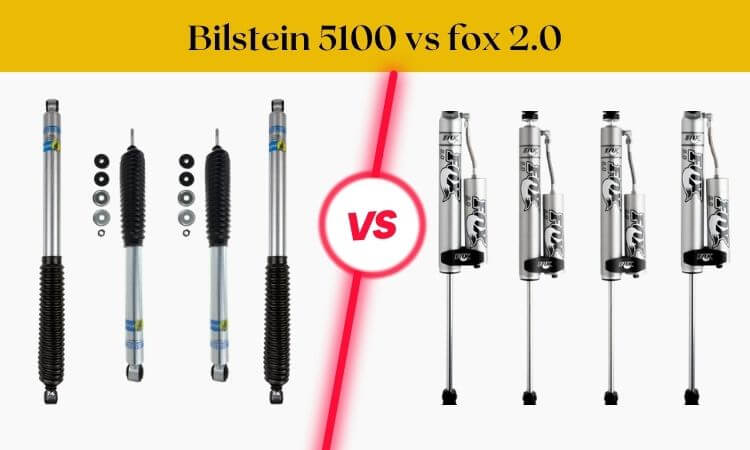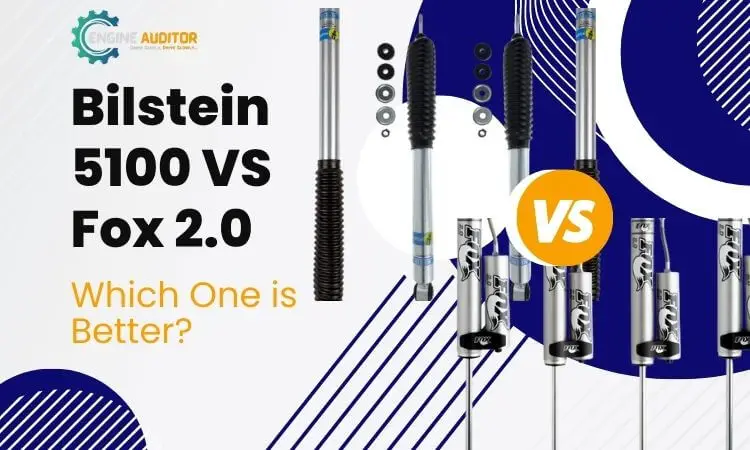Hey there! This post contains affiliate links to products. We may receive a commission for purchases made through these links. But it never influences our product selection process.
Upgrading the vehicle’s suspension can help make your ride smooth. However, two well-liked options for upgrading suspension systems are the Bilstein 5100 and Fox 2.0. Both are excellent performers, but which one is the better shock absorber?
The Bilstein 5100 shocks offer solid construction, reliable performance, and a firm damping feel, providing stability and control off-road. The Fox 2.0 shocks have a slightly larger tube diameter, a wider shaft, and softer damping, resulting in a smoother on-road ride but a higher risk of bottoming out off-road. However, both shocks are easy to install and offer good value, with the Bilstein 5100 generally being more affordable.
Buckle up and Join me as I explore Bilstein 5100 vs Fox 2.0 to find the best one. Let’s find out the best shock absorber to meet your demands.
Wool Wax vs Fluid Film: Exploring top-notch rust prevention solutions for your vehicle. Dive into their features and performance to safeguard against corrosion and prolong your vehicle’s life.
Quick Overview
| Highlighted Features | Bilstein 5100 | Fox 2.0 |
| Construction | Smaller in size | Larger and better damping features |
| Performance | Reliable performance | Softer damping feel |
| Easy Installation | Easy | Easy |
| On-Road Performance | Good Performance | Excellent Performance |
| Off-Road Performance | Excellent Performance | Good Performance |
| Price and Value | Affordable | Expensive |
Bilstein 5100 Overview
The Bilstein 5100 is a highly regarded suspension system known for its exceptional off-road performance. Designed for various vehicle models, including the F-150, Ram 2500, and Toyota 4Runner. It offers a comfortable ride and improved handling on rugged terrain.
Check Latest PriceThe Pros:
- Superior damping capability for improved control and stability
- Adjustable ride height for customization and leveling
- Monotube design for efficient heat dissipation
- Enhanced durability and resistance to corrosion
The Cons:
- Limited adjustability compared to some competitors
- The relatively higher price point
Customer Reviews and Feedback:
Numerous customers have expressed their satisfaction with the Bilstein 5100 suspension system. They praise its ability to deliver a smooth ride and improved off-road performance. Some users specifically highlight its performance on the F-150, Ram 2500, and 4Runner, where it significantly enhances the driving experience.
Fox 2.0 Overview
The Fox 2.0 shock uses nitrogen gas to stand out for its rebuildable and rechargeable nature. It means it can last the entire lifespan of a vehicle. For street-only use, Fox recommends servicing the 2.0 shocks every 50,000 miles. But for more intense usage, evaluation every 10,000 miles is advised. The Fox 2.0 offers exceptional suspension and balanced performance on and off the road. However, it comes at a higher price than the Bilstein 5100 shock.
Check Latest PriceThe Pros:
- It ensures better ride quality and excellent damping control
- Its Aluminum material makes it lightweight and durable
- Highly adjustable for personalized tuning
- Reservoir design for improved heat dissipation
The Cons:
- Slightly expensive to some competitors
- Limited applications for certain vehicle models
Customer Reviews and Feedback:
Customers look satisfied with the Fox 2.0 suspension system. They praised its ability to handle rough terrains and ensure excellent performance easily. It receives 5 stars in performance. However, some clients complain about the price. They said the price is too high compared to its features.
Bilstein 5100 vs fox 2.0

Construction:
The Bilstein 5100 and Fox 2.0 shocks have notable constructional differences. Fox 2.0 shock has a slightly larger tube diameter than the Bilstein 5100. Furthermore, Fox 2.0 also has a wider shaft and better damping capabilities.
Performance:
In performance comparison, we found the Bilstein 5100 shocks are solid, which may ensure more reliable performance. They offer a firm damping feel, providing stability and control during various off-road conditions. On the other hand, the Fox 2.0 shocks offer softer damping features. You may find it more comfortable while driving on washboard roads. However, it may also result in more bottoming out while you are driving off-road.
Easy Installation:
Both shock absorbers are simple to install, especially on newer Jeep models like the JLU and JT. Shocks can be easily changed without altering the suspension system. Such a feature makes both of them fast and easy to install.
On-Road Performance:
The Fox 2.0 shocks provide a smoother ride over bumps and road imperfections during on-road driving. The softer dampening allows for improved comfort, especially on washboard roads. On the other hand, the Bilstein 5100 shocks, with their firmer dampening, offer a more controlled and stable feel. It minimizes body roll and provides a sportier driving experience.
Off-Road Performance:
When taken off-road, both shocks demonstrate their capabilities. The Fox 2.0 shocks absorb smaller bumps and undulations, providing a plush ride. However, they may be more prone to bottoming out on larger obstacles due to their softer dampening. The Bilstein 5100 shocks offer firmer dampening, improving control and reducing bottoming out on aggressive terrain.
Price and Value:
The Bilstein 5100 shocks generally have a lower price point than the Fox 2.0 shocks. However, the value of each shock depends on individual preferences and requirements. If you prioritize a softer and more comfortable ride, the Fox 2.0 shocks may be worth the additional investment. On the other hand, if you prioritize firm control and stability, the Bilstein 5100 shocks offer excellent value.
How Long Do Bilstein Shocks Last?
Bilstein shocks typically last over 100,000 miles, based on extensive customer feedback. Their durability and low warranty rates contribute to the brand’s reputation for longevity.
How Long Do Fox 2.0 Shocks Last?
Fox’s 2.0 shocks generally last around 50,000 miles for street-only use. However, if you subject them to frequent, intense use, it is advisable to assess their condition every 10,000 miles by checking the shafts for any issues and looking for seepage or leakage.
Which Suspension System is Right for You?
Bilstein 5100 shocks provide excellent damping and have robust construction. Off-road, it provides better stability and control. It is an easy-to-install device that provides a controlled and stable ride on the road.
The Fox 2.0 shocks have a larger tube diameter, softer damping features, and better damping capabilities. Especially on washboard roads, it provides a smoother ride. However, off-road driving may cause you to bottom out more often.
The Fox 2.0 shocks are expensive but an excellent choice if comfort is a priority. However, if firm control and stability are more important, then Bilstein 5100 shocks are affordable.
Frequently Asked Questions (FAQs):
Is Bilstein 5100 worth it?
Are Bilstein 5100 shocks good for towing?
Are Fox 2.0 shocks any good?
How often do you rebuild Fox 2.0 shocks?
Conclusion
Both the Bilstein 5100 and Fox 2.0 are excellent options for updating the suspension system. Each of them offers unique advantages. The Bilstein 5100 is an affordable, durable, and excellent performer off-road. On the other hand, the Fox 2.0 is an expensive but smoother and comfortable option on-road. However, the choice between the two will depend on your specific needs and preferences.



